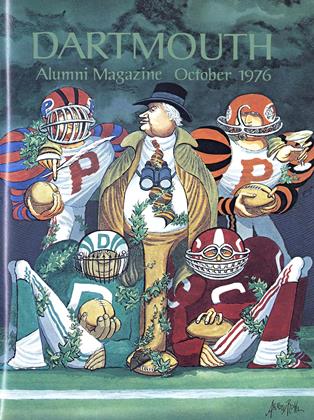You can tell the times from the music
GREAT GRANDMOTHER sings the songs she remembers — songs of the teary "Gay Nineties," when America was trying to grow up. Grandmother sings the wistful patriotic songs of 50 years ago when she was a girl. Grandfather prefers the jazzy carefree songs of the twenties because he pretends not to be so old as Grandmother. He liked the hand-cranked phonograph on the front porch by the hammock on summer evenings before Grandmother and he were married. They would snuggle in the hammock while the machine churned out a tinny version of "It Had to be You." Every now and then he would have to climb out of the hammock to rewind the phonograph and turn the disc over to the other — side - "If You Knew Susie," or some such tidbit. Meanwhile, Grandmother rearranged her hair and tried to calm down.
Father likes the big bands of the late thirties with their tremendous coordination of sound. Mother likes those dance tunes also, but they tug at her heart because they remind her of the loneliness of those war years when Father and 20 million others were out of town on military service.
Some of those popular songs are still sung and probably always will be sung; such "classics" have the indefinable quality of words and melody which seem to make them imperishable.
Most songs of the past have faded from view; they had their heyday, but the world kept changing, America kept growing up. So the popular song industry tossed out the unsaleable junk and wrote new numbers to keep pace with the developing times. Nevertheless, those faded songs reflect the social life of their times in ways which give social historians pause for thought. The all-time Non-Hit Parade is a lode of historical material which awaits those students of American life who conceive of history as a living experience rather than a dustbin of dry statistics.
Some of these faded songs are presented here, with a brief comment on their significance as mirrors of the times when they were created. Musically they perhaps have little worth. Occasionally the lyrics are worthy of study. The covers of the songs are often interesting and revealing.
1913. The Big City loomed as agreat temptation to the lonesomecountry girl pining away down onthe farm. The songwriters claimthat many of them ran away from
the farm to the city, for better orfor worse. This must be the FateWorse Than Death that Grandmothersometimes talked about.
1913. Not too much was said aboutit, but in 1913 there was some hanky panky going on, here andthere. These songs allude tovarious situations and characteristicswhich politely could be termed"naughty," "spicy," "forward," orpick out your own adjective.
1917. There were lots of patrioticmarch tunes written during WorldWar I, for two reasons. First, therewas a lot of patriotism around inthose days. We firmly believed we
were out to save the world forDemocracy. Second, the Armytruly was a marching army, forthat was the only way it could getaround.
1924. This was known as the JazzAge, to use another of jazz's manymeanings. Girls did such things assmoke cigarettes and roll theirstockings so that the roll could beseen under their short skirts. Thegroup of songs shown include apicture of a well-known artist whofeatured the song, including ayouthful Fred Waring.
1931 was pretty much a sexy eraif you can believe what you see onthe song covers. On secondthought, all the clinches by themovie stars would probably be
rated GP today. It's a man'sworld, please note. The women allseem to be' overpowered by theiramorous partners.
1939. This was the heyday of thebig bands, the big ballrooms, andeverybody danced, or jitterbugged,as the case may be. These foursongs all feature one of the leadingbandmasters of the day. It wasn't
until World War II ended that thebig band fell prey to the guitar andits noisy consort, the guitaramplifier.
1945. Because we had sufferedsome disillusionment over theyears since World War I, ourpatriotism had become eroded.Moreover, the big bands were stillswinging, and soldiers were ridingon wheels rather than marching onfoot. World War II produced nopatriotic songs and no marchingsongs. The war songs of the forties,as presented by the big bands, dealtmostly with loneliness and longing.
Roger Burrill, secretary of the Class of1931, recently donated his collection ofsome 12,000 pieces of sheet music to BakerLibrary.
 View Full Issue
View Full Issue
More From This Issue
-
 Feature
FeatureTHE IVORY FOXHOLE
October 1976 By JEFFREY HART -
 Feature
FeatureMENAGE A HUIT
October 1976 By ROGERS E. M. WHITAKER -
 Feature
FeatureRED BALLING IN THE JERSEY NIGHT
October 1976 By Jeffrey Brodrick -
 Article
Article'My Own House'
October 1976 By ALLEN L. KING -
 Article
ArticleAlumni Fund Chairman's Report
October 1976 -
 Article
ArticleLurch and the Munchkins
October 1976 By JACK DEGANGE
Features
-
 Feature
FeatureThe Senior Fellows: Seventeen Paths to Independent learning
MARCH 1966 -
 Cover Story
Cover StoryInauguration of the 14th President: The Spirit of Eleazar Wheelock ... Transmitted through his Successors'
SEPTEMBER 1981 -
 Cover Story
Cover StoryJake Winebaum '81
March 1993 -
 Feature
FeatureBeyond The Limits
June 1992 By Donella Meadows -
 Cover Story
Cover StoryHOW TO MAKE A GOAL KICK
Sept/Oct 2001 By KRISTIN LUCKENBILL '01 -
 Feature
FeatureA Tuckerman Tradition
April 1956 By ROBERT S. MONAHAN '29






